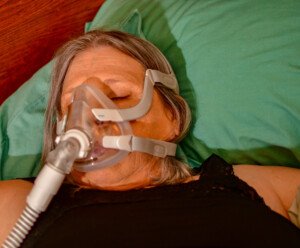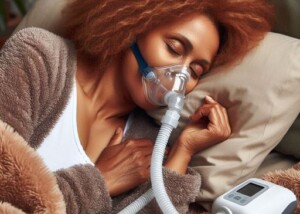
How many people with sleep apnea do not improve despite using a CPAP machine and why does this occur?
After all, CPAP therapy is the gold standard treatment for sleep apnea with a highly effective result for people who comply with this treatment.
Certainly, we wouldn’t expect a person to improve much if they don’t use the CPAP machine consistently.
Patients are supposed to use it for the entire duration of their sleep. This means if they wake up an hour before they’re supposed to get up for the day to use the toilet and then go back to sleep for just one more hour – the CPAP is still supposed to go back on.
People Who Comply with CPAP but Don’t Get Better
For some individuals who adhere to CPAP therapy, sleep apnea symptoms do not improve.
This is noticeable via the continuing daytime drowsiness, irritability, and/or overnight trips to the bathroom or morning headaches.
Though these symptoms can have other causes unrelated to sleep-disordered breathing, the one data piece that’s an indisputable measure of a CPAP machine’s effect is the apnea-hypopnea index number (AHI).
Regardless of symptoms, if the AHI result the following morning is the same or near the same as it was pre-treatment, then something is very wrong.
Ideally it should be below five.
Improper use of the machine will reduce effectiveness. The patient first needs to make sure that they are using it properly. Another consultation with the DME provider is in order.
If correct use of the CPAP machine fails to solve the problem, then maybe the issue is your nose.
Nasal Problems with CPAP
“The most common reason that people cannot handle a CPAP is that they have nasal stuffiness or a deviated septum, or both,” says Dr. C. Phillip Amoils, MD, a board certified otolaryngologist with SC-ENT Ear, Nose & Throat Specialists in CA.
“The CPAP is blowing dry air, or even slightly humidified air, into the nose — and what happens is that you’re congested, so it’s like blowing into a narrow tube.
“The CPAP has a hard time doing it and it’s also very uncomfortable for the patient.”
There is no precise data on just how many people, or what percentage, fail to improve with CPAP with compliant use, or with non-adherence for that matter.
But it’s puzzling to still see an AHI in the sleep apnea range after loyal and correct use of the CPAP.
When this occurs, the patient needs to aggressively pursue this, including the idea of trying a different type of CPAP machine.
If the patient is obese, weight loss may be the very thing that helps get the AHI lowered.
Solution to the Congested Nose
Dr. Amoils says, “Treatment is quite easy — you can shrink the membranes of the nose using radiofrequency, or do deviated septum surgery (i.e., a nasal septoplasty).”
One more thing to consider:
Make sure that you are vigilant about keeping your CPAP device sanitized at all times.

Dr. Amoils is considered among the best surgeons worldwide for sinus surgery and OSA, having helped thousands of patients for 30+ years. He also demonstrates to physicians the protocols he’s developed for mouth breathing, nasal congestion, obstructive sleep apnea and snoring using minimally invasive procedures.
 Lorra Garrick has been covering medical, fitness and cybersecurity topics for many years, having written thousands of articles for print magazines and websites, including as a ghostwriter. She’s also a former ACE-certified personal trainer.
Lorra Garrick has been covering medical, fitness and cybersecurity topics for many years, having written thousands of articles for print magazines and websites, including as a ghostwriter. She’s also a former ACE-certified personal trainer.
.


























